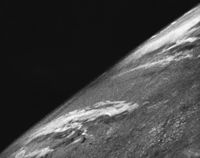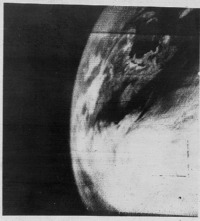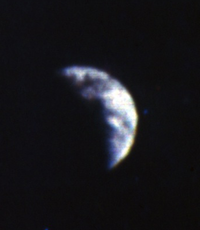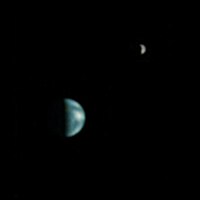Timeline of first images of Earth from space
Appearance
This is a timeline of first images of Earth from space. The initial photographs and digital images of planet Earth taken from outer space were preceded by aerial photography and continue in the form of satellite imagery.
For the purpose of this list, a spaceflight is defined as any flight that crosses the Kármán line, the FAI-recognized edge of space, which is 100 kilometres (62 miles) above mean sea level (AMSL).
Milestones in Earth imaging
| Ano | País | Evento | Imagem | Refs |
|---|---|---|---|---|
| 1946 | 24 October 1946 – V-2: first image of Earth from outer space, taken by the V-2 No. 13 suborbital spaceflight. | 
|
[1][2] [3][4] [5][6] [7][8] | |
| 1947 | 7 March 1947 – First panorama of Earth from outer space, taken by a V2 rocket. | 
|
[9] | |
| 1959 | Explorer 6: first image of Earth from orbit, showing a sunlit area of the Central Pacific Ocean and its cloud cover. | 
|
[10][11][12] | |
| 1959 | Vanguard 2: first attempt of a scanner, in which a single photocell mounted at the focus of telescope would scan Earth due to the satellite movement; resulting images were poor. | 
|
[13] | |
| 1959 | Explorer 7 (launched on October 13, 1959): the first "coarse maps of the solar radiation reflected by the Earth and the infrared radiation emitted by the Earth". | 
|
[14] | |
| 1960 | TIROS-1: first live television image of Earth from space and first weather satellite picture. | 
|
[15] | |
| 1960 | Corona: "first space-based earth observation system";[16] its first successful mission was Discoverer 14 on 1960-08-19 with the recovery of photographic film from an orbiting satellite.[17] | 
|
[16][17] | |
| 1963 | KH-7 Gambit: first high-resolution (sub-meter spatial resolution) satellite photography (classified). | 
|
[18] | |
| 1964 | Quill: first radar images of Earth from space, using a synthetic aperture radar (SAR). | 
|
[19] | |
| 1966 | Molniya 1-3: first full-disk pictures of the Earth, on May 30, 1966. | 
|
[20] | |
| 1966 | ATS-1: first full-disk pictures of the Earth from a geostationary orbit, on December 11, 1966. | 
|
[21] | |
| 1966 | Lunar Orbiter 1: first image of Earth from the Moon's orbit. | 
|
[22][23][24][7][12] | |
| 1967 | Surveyor 3: first image of Earth from the Moon's surface. | 
|
[25] | |
| 1967 | DODGE: first full-disk color pictures of the Earth. | 
|
[6] | |
| 1967 | ATS-3: another claim for first full-disk color pictures of the Earth;[26] subsequently used on the cover of the first Whole Earth Catalog.[26] | 
|
[27][26] | |
| 1968 | Apollo 8: first image of Earth from space taken by a human, probably by astronaut William Anders. | 
|
[28] | |
| 1968 | Earthrise: first color image of Earth from the Moon, Earthrise, also by Apollo 8 astronaut William Anders. | 
|
[23][6][12] | |
| 1977 | KH-11: first real-time satellite imagery. | 
|
[29] | |
| 1999 | IKONOS: first commercial high-resolution (sub-meter) satellite photography (non-classified); it made the cover of the New York Times on October 13, 1999. | 
|
[30] |
Other notable instances (non-firsts)
| Ano | País | Evento | Imagem | Refs |
|---|---|---|---|---|
| 1972 | 7 December 1972: the widely used The Blue Marble was taken by the crew of Apollo 17.[23] The photograph's original orientation had south pointed up.[31] |  
|
[23][6][24][12][31] | |
| 1990 | 14 February 1990: the Voyager 1 space probe took the Pale Blue Dot photograph of Earth from a record distance of about 6 billion kilometers (3.7 billion miles, 40.5 AU), as part of that day's Family Portrait series of images of the Solar System. Earth appears as a tiny dot within deep space: the blueish-white speck almost halfway up the brown band on the right. Diagram of the Family Portrait showing the planets' orbits and the relative position of Voyager 1 when the mosaic was captured. |
 
|
[12][32] | |
| 2001-2004 | Blue Marble Next Generation. Blue Marble composite images generated by NASA in 2001 and 2002.[6] NASA Earth Observatory animation of Blue Marble Next Generation (2004); see also interactive map of monthly snapshots) |
 
|
[33][6] | |
| 2010 | The Cupola is installed at the ISS and provides since a wealth of intricate images of Earth from orbit. | 
|
[34] | |
| 2010 | Family Portrait (MESSENGER) | 
|
[6] | |
| 2013 | The Day the Earth Smiled – 2013 photograph of Saturn and Earth | 
|
[12] | |
| 2015 | Launch of Deep Space Climate Observatory (DSCOVR). The Moon moving in front of Earth in July 2016. The far side of the Moon faces the camera.[32] | 
|
[35][32] | |
| 2020 | Family portrait of three rocky planets (Earth, Venus, Mars) from inside their orbits by the Solar Orbiter spacecraft. | 
|
[36] |
Imaging of Earth from Mars
| Ano | País | Evento | Imagem | Refs |
|---|---|---|---|---|
| 2003 | Earth and Moon, imaged by Mars Global Surveyor from its orbit around Mars on May 8, 2003, 13:00 UTC. South America is visible. | 
|
[23][6] | |
| 2014 | Curiosity's first view of the Earth and the Moon from the surface of Mars (January 31, 2014). | 
|
[37] | |
| 2016 | Earth and the Moon as viewed from orbit around Mars (MRO; HiRISE; November 20, 2016) |

|
[38] |
See also
- Earth observation – Information about the Earth environment, remote or in situ
- Artificial structures visible from space – Human-made things that can be seen from space
- Earth phase – Phases of the Earth as seen from the Moon
- First light (astronomy) – Term in astronomy for the first time a telescope is used to look at the Universe
- List of Earth observation satellites
- Pale Orange Dot, a NASA digital model showing a possible early Earth
- Overview effect – Cognitive shift caused by viewing Earth from outer space
References
- ^ "First Photo From Space". October 24, 2006. Archived from the original on January 29, 2021.
- ^ "The First Image of Earth Taken From Space (It's Not What You Think)". August 6, 2012. Archived from the original on August 8, 2020.
- ^ "First photo of Earth from space was from deadly rocket". February 26, 2015. Archived from the original on November 8, 2020.
- ^ "70 years ago the first image of Earth was taken from space". October 26, 2016. Archived from the original on October 29, 2016.
- ^ "The First Photo of Earth From Space Was Taken 70 Years Ago Today". October 24, 2016. Archived from the original on October 25, 2016.
- ^ a b c d e f g h "Viewing The Earth From Space Celebrates 70 Years". August 22, 2016. Archived from the original on August 23, 2016.
- ^ a b "Space Photos Before NASA: The Oldest Images Of Earth". October 28, 2017. Archived from the original on October 28, 2017.
- ^ "The first photograph of Earth taken from space". October 24, 2017. Archived from the original on June 17, 2018.
- ^ "First Pictures of Earth From 100 Miles in Space, 1947". March 6, 2009. Archived from the original on March 7, 2009.
- ^ "Explorer 6: 60 years since first Earth photo from space". August 7, 2019. Archived from the original on August 8, 2019.
- ^ "60 years ago first satellite image of Earth". September 7, 2019. Archived from the original on September 7, 2019.
{{cite web}}:|archive-date=/|archive-url=timestamp mismatch; September 7, 2020 suggested (help) - ^ a b c d e f "60 Years Ago We Saw Earth From Space for the First Time — Here's How We See It Now". August 22, 2019. Archived from the original on August 23, 2019.
- ^ "Vanguard II Turns 60". April 23, 2019. Archived from the original on March 18, 2021. Retrieved March 27, 2021.
- ^ Kidder, S.Q.; Vonder Haar, T.H. (1995). Satellite Meteorology: An Introduction. Elsevier Science. p. 2. ISBN 978-0-08-057200-0. Retrieved October 5, 2020.
- ^ Anderson, George D. (April 1, 2010). "The first weather satellite picture". Weather. 65 (4): 87. Bibcode:2010Wthr...65...87A. doi:10.1002/wea.550. ISSN 1477-8696.
- ^ a b "2005 Draper Prize – Corona Historic Images". NAE Website.
- ^ a b "Discoverer 14 – NSSDC ID: 1960-010A". NASA.
- ^ "USGS EROS Archive – Declassified Data – Declassified Satellite Imagery – 2". Archived from the original on February 29, 2020. Retrieved March 18, 2021.
- ^ Robert L. Butterworth "Quill: The First Imaging Radar Satellite" [1]
- ^ Joel Achenbach (January 3, 2012). "Spaceship Earth: The first photos". Retrieved June 16, 2020.
- ^ "The 50th Anniversary of ATS-1". NOAA National Environmental Satellite, Data, and Information Service (NESDIS). December 6, 2016. Retrieved October 5, 2020.
- ^ Stein, Ben P. (August 23, 2011). "45 Years Ago: How the 1st Photo of Earth From the Moon Happened". Space.com. Retrieved October 7, 2020.
- ^ a b c d e "Milestones in Space Photography". Archived from the original on January 4, 2020.
{{cite web}}:|archive-date=/|archive-url=timestamp mismatch; April 1, 2020 suggested (help) - ^ a b "Fifty Years Ago, This Photo Captured the First View of Earth From the Moon". August 23, 2016. Archived from the original on August 25, 2016.
- ^ "First image of Earth from the surface of the Moon: Surveyor 3". The Planetary Society. Archived from the original on September 24, 2020.
- ^ a b c @SciHistoryOrg (April 24, 2020). "Science History Institute on Twitter" (Tweet) – via Twitter.
- ^ "Our SpaceFlight Heritage: ATS-3 relays first color images of Earth". November 10, 2014. Archived from the original on November 11, 2020. Retrieved March 27, 2021.
- ^ Woods, W. David; O'Brien, Frank (2006). "Day 1: The Green Team and Separation". Apollo 8 Flight Journal. NASA. Archived from the original on September 23, 2008. Retrieved October 29, 2008. TIMETAG 003:42:55.
- ^ "Spying on a Hubble Telescope Look-Alike". May 29, 2010. Archived from the original on February 14, 2021. Retrieved March 27, 2021.
- ^ "IKONOS 20th Anniversary". Archived from the original on March 27, 2021. Retrieved March 27, 2021.
- ^ a b Reinert, Al (April 12, 2011). "The Blue Marble Shot: Our First Complete Photograph of Earth". The Atlantic. Retrieved August 1, 2018.
- ^ a b c "Our home world from afar". April 22, 2020. Archived from the original on December 1, 2020.
- ^ "Blue Marble next generation". October 13, 2005. Archived from the original on March 20, 2021. Retrieved March 27, 2021.
- ^ "Cupola Observational Module". Archived from the original on December 11, 2020. Retrieved March 27, 2021.
- ^ "DSCOVR: Deep Space Climate Observatory". Archived from the original on March 27, 2021. Retrieved March 27, 2021.
- ^ Starr, Michelle (January 30, 2021). "Family Photo Snapped by Solar Orbiter Shows Venus, Earth And Mars Gleaming Like Stars". ScienceAlert. Retrieved January 31, 2021.
- ^ Revkin, Andrew C. (February 6, 2014). "Martian View of Our Pale Dot". The New York Times. Retrieved February 9, 2014.
- ^ St. Fleur, Nicholas (January 9, 2017). "Looking at Your Home Planet from Mars". The New York Times. Retrieved January 9, 2017.
